TOYOTA HILUX 2019 Workshop Manual
Manufacturer: TOYOTA, Model Year: 2019, Model line: HILUX, Model: TOYOTA HILUX 2019Pages: 708, PDF Size: 95.31 MB
Page 51 of 708
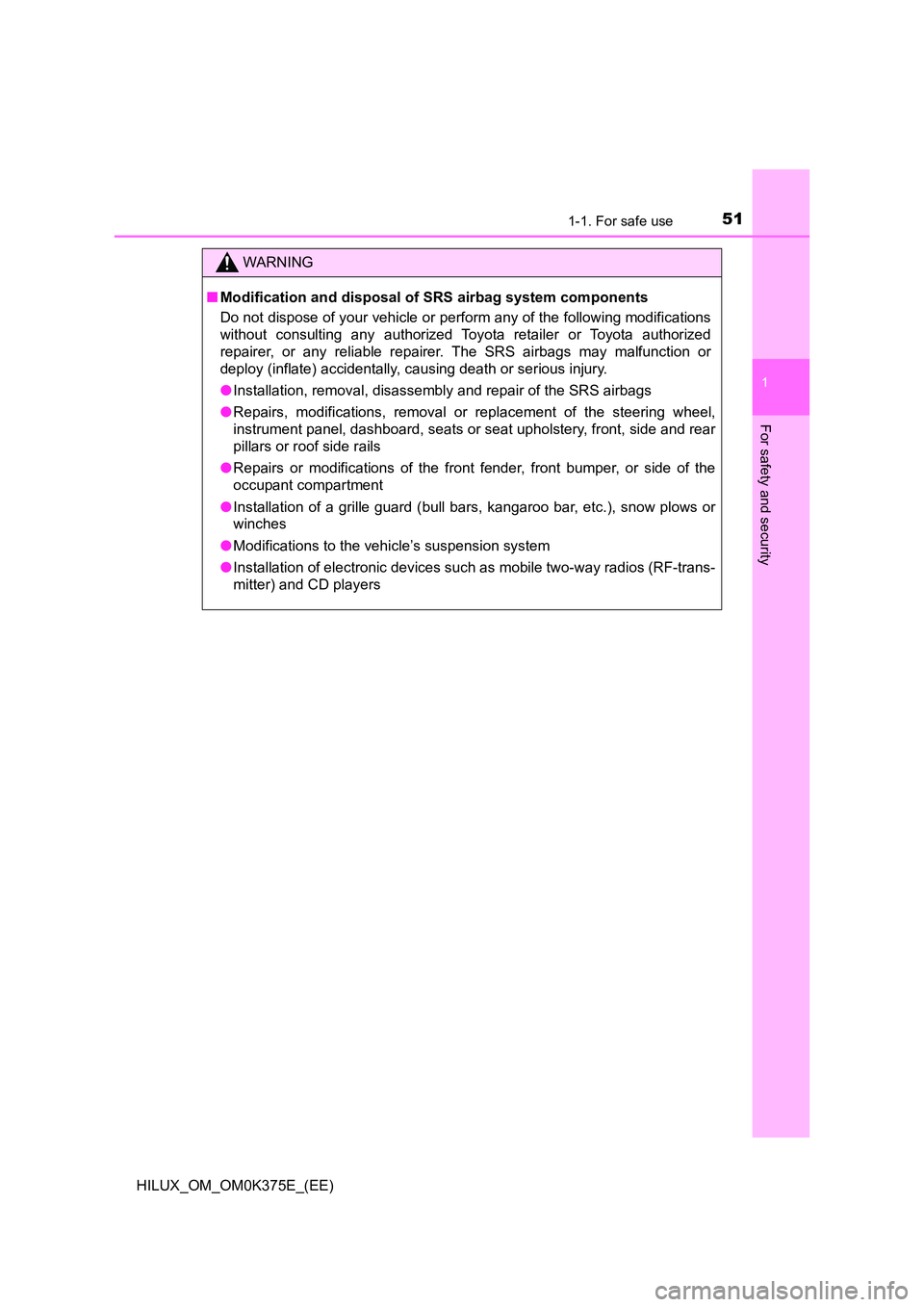
511-1. For safe use
1
HILUX_OM_OM0K375E_(EE)
For safety and security
WARNING
■Modification and disposal of SRS airbag system components
Do not dispose of your vehicle or perform any of the following modifications
without consulting any authorized Toyota retailer or Toyota authorized
repairer, or any reliable repairer. The SRS airbags may malfunction or
deploy (inflate) accidentally, causing death or serious injury.
● Installation, removal, disassembly and repair of the SRS airbags
● Repairs, modifications, removal or replacement of the steering wheel,
instrument panel, dashboard, seats or seat upholstery, front, side and rear
pillars or roof side rails
● Repairs or modifications of the front fender, front bumper, or side of the
occupant compartment
● Installation of a grille guard (bull bars, kangaroo bar, etc.), snow plows or
winches
● Modifications to the vehicle’s suspension system
● Installation of electronic devices such as mobile two-way radios (RF-trans-
mitter) and CD players
Page 52 of 708
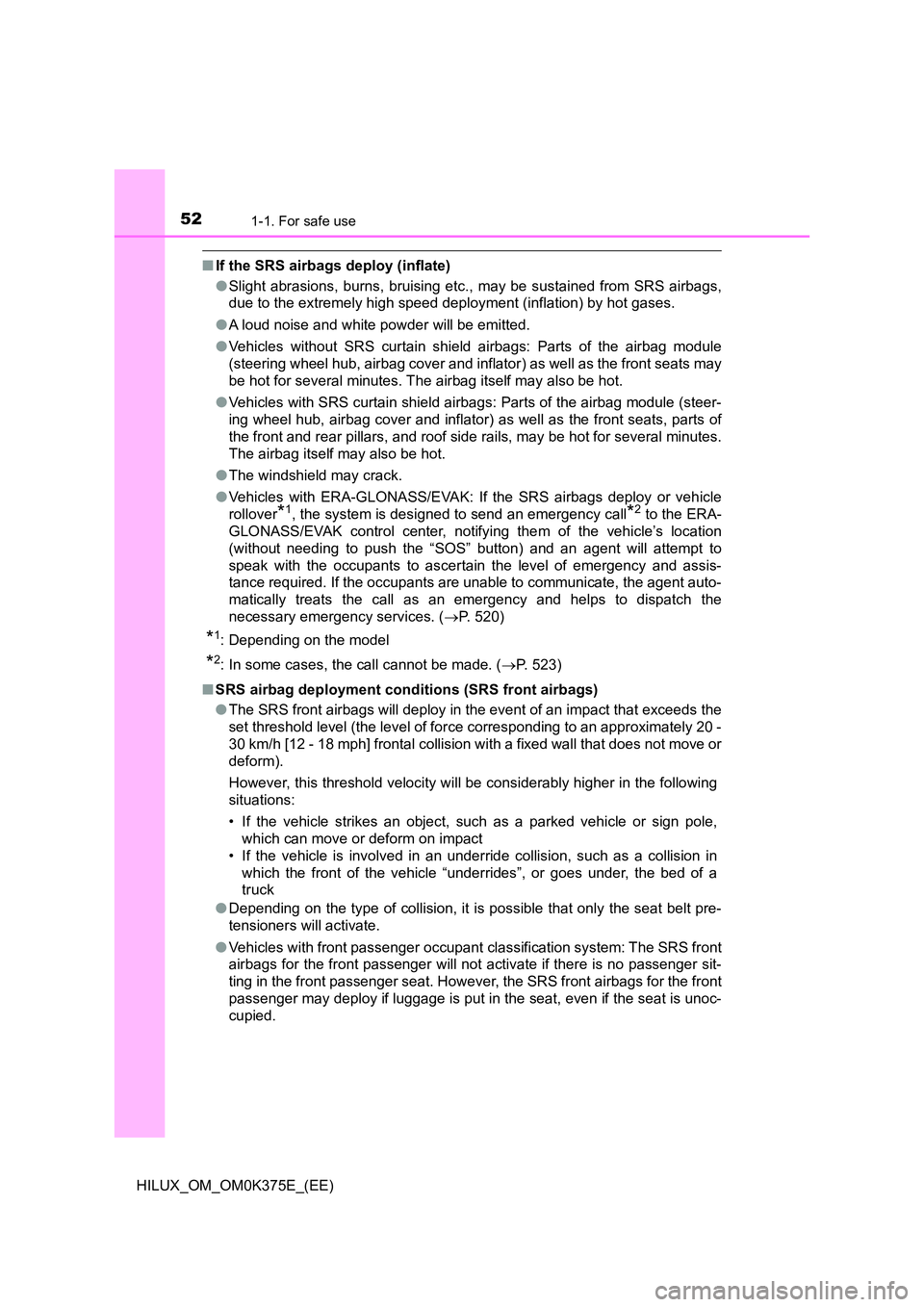
521-1. For safe use
HILUX_OM_OM0K375E_(EE)
■If the SRS airbags deploy (inflate)
● Slight abrasions, burns, bruising etc., may be sustained from SRS airbags,
due to the extremely high speed deployment (inflation) by hot gases.
● A loud noise and white powder will be emitted.
● Vehicles without SRS curtain shield airbags: Parts of the airbag module
(steering wheel hub, airbag cover and inflator) as well as the front seats may
be hot for several minutes. The airbag itself may also be hot.
● Vehicles with SRS curtain shield airbags: Parts of the airbag module (steer-
ing wheel hub, airbag cover and inflator) as well as the front seats, parts of
the front and rear pillars, and roof side rails, may be hot for several minutes.
The airbag itself may also be hot.
● The windshield may crack.
● Vehicles with ERA-GLONASS/EVAK: If the SRS airbags deploy or vehicle
rollover*1, the system is designed to send an emergency call*2 to the ERA-
GLONASS/EVAK control center, notifying them of the vehicle’s location
(without needing to push the “SOS” button) and an agent will attempt to
speak with the occupants to ascertain the level of emergency and assis-
tance required. If the occupants are unable to communicate, the agent auto-
matically treats the call as an emergency and helps to dispatch the
necessary emergency services. ( P. 520)
*1: Depending on the model
*2: In some cases, the call cannot be made. (P. 523)
■ SRS airbag deployment conditions (SRS front airbags)
● The SRS front airbags will deploy in the event of an impact that exceeds the
set threshold level (the level of force corresponding to an approximately 20 -
30 km/h [12 - 18 mph] frontal collision with a fixed wall that does not move or
deform).
However, this threshold velocity will be considerably higher in the following
situations:
• If the vehicle strikes an object, such as a parked vehicle or sign pole,
which can move or deform on impact
• If the vehicle is involved in an underride collision, such as a collision in
which the front of the vehicle “underrides”, or goes under, the bed of a
truck
● Depending on the type of collision, it is possible that only the seat belt pre-
tensioners will activate.
● Vehicles with front passenger occupant classification system: The SRS front
airbags for the front passenger will not activate if there is no passenger sit-
ting in the front passenger seat. However, the SRS front airbags for the front
passenger may deploy if luggage is put in the seat, even if the seat is unoc-
cupied.
Page 53 of 708
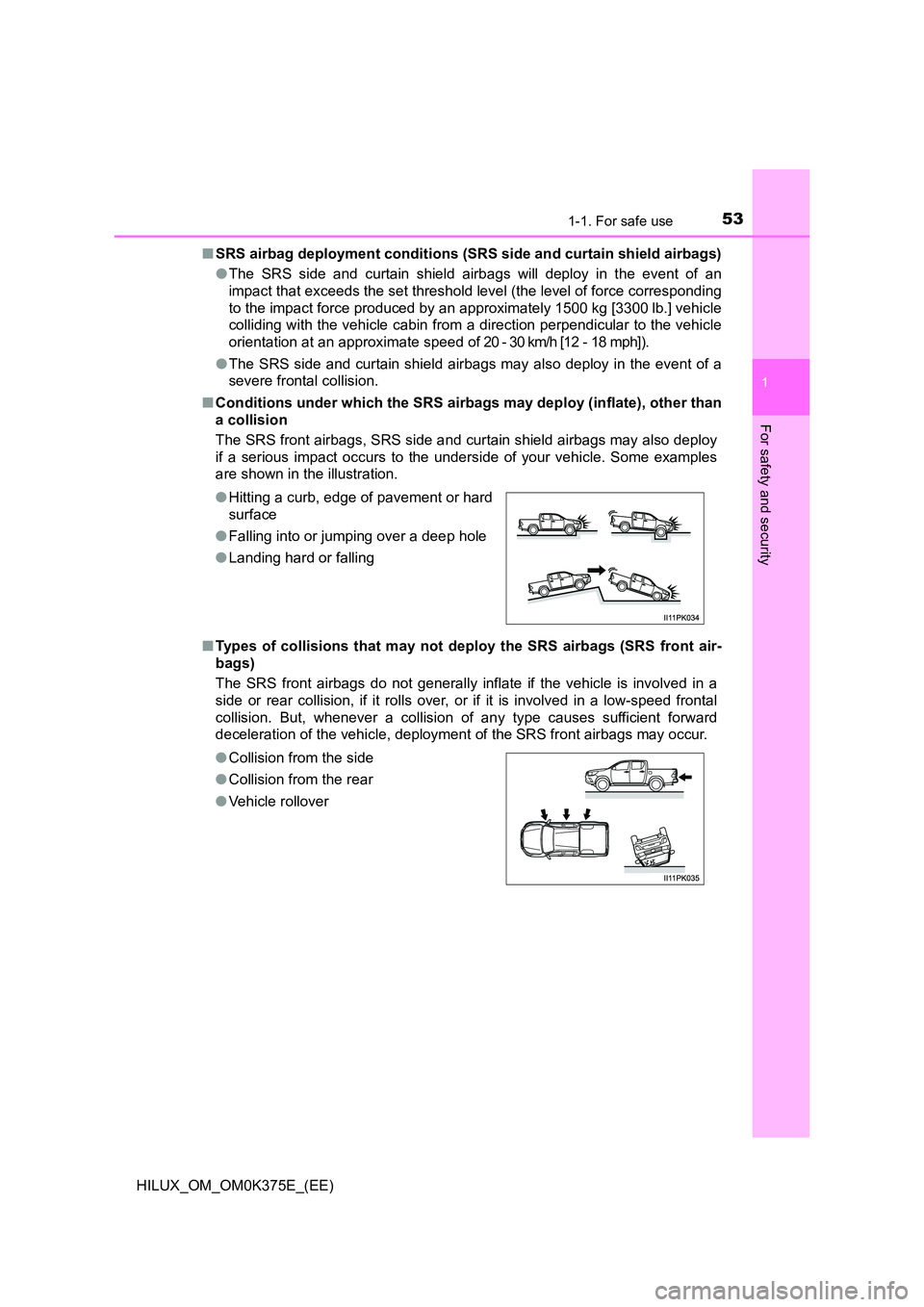
531-1. For safe use
1
HILUX_OM_OM0K375E_(EE)
For safety and security
■SRS airbag deployment conditions (SRS side and curtain shield airbags)
● The SRS side and curtain shield airbags will deploy in the event of an
impact that exceeds the set threshold level (the level of force corresponding
to the impact force produced by an approximately 1500 kg [3300 lb.] vehicle
colliding with the vehicle cabin from a direction perpendicular to the vehicle
orientation at an approximate speed of 20 - 30 km/h [12 - 18 mph]).
● The SRS side and curtain shield airbags may also deploy in the event of a
severe frontal collision.
■ Conditions under which the SRS airbags may deploy (inflate), other than
a collision
The SRS front airbags, SRS side and curtain shield airbags may also deploy
if a serious impact occurs to the underside of your vehicle. Some examples
are shown in the illustration.
■ Types of collisions that may not deploy the SRS airbags (SRS front air-
bags)
The SRS front airbags do not generally infl ate if the vehicle is involved in a
side or rear collision, if it rolls over, or if it is involved in a low-speed frontal
collision. But, whenever a collision of any type causes sufficient forward
deceleration of the vehicle, deployment of the SRS front airbags may occur.
● Hitting a curb, edge of pavement or hard
surface
● Falling into or jumping over a deep hole
● Landing hard or falling
● Collision from the side
● Collision from the rear
● Vehicle rollover
Page 54 of 708
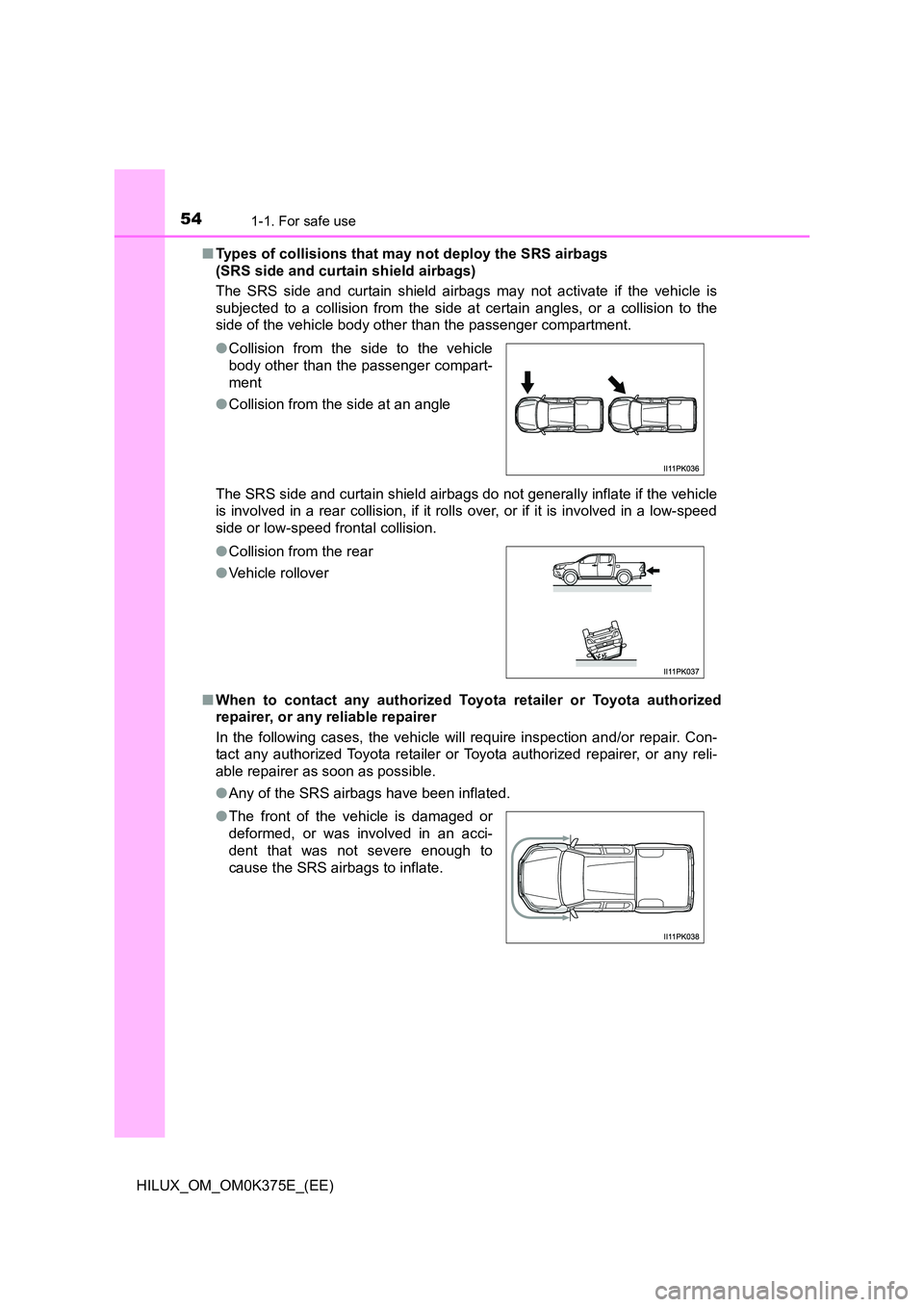
541-1. For safe use
HILUX_OM_OM0K375E_(EE)
■ Types of collisions that may not deploy the SRS airbags
(SRS side and curtain shield airbags)
The SRS side and curtain shield airbags may not activate if the vehicle is
subjected to a collision from the side at certain angles, or a collision to the
side of the vehicle body other than the passenger compartment.
The SRS side and curtain shield airbags do not generally inflate if the vehicle
is involved in a rear collision, if it rolls over, or if it is involved in a low-speed
side or low-speed frontal collision.
■ When to contact any authorized Toyota retailer or Toyota authorized
repairer, or any reliable repairer
In the following cases, the vehicle will require inspection and/or repair. Con-
tact any authorized Toyota retailer or Toyota authorized repairer, or any reli-
able repairer as soon as possible.
● Any of the SRS airbags have been inflated.
● Collision from the side to the vehicle
body other than the passenger compart-
ment
● Collision from the side at an angle
● Collision from the rear
● Vehicle rollover
● The front of the vehicle is damaged or
deformed, or was involved in an acci-
dent that was not severe enough to
cause the SRS airbags to inflate.
Page 55 of 708
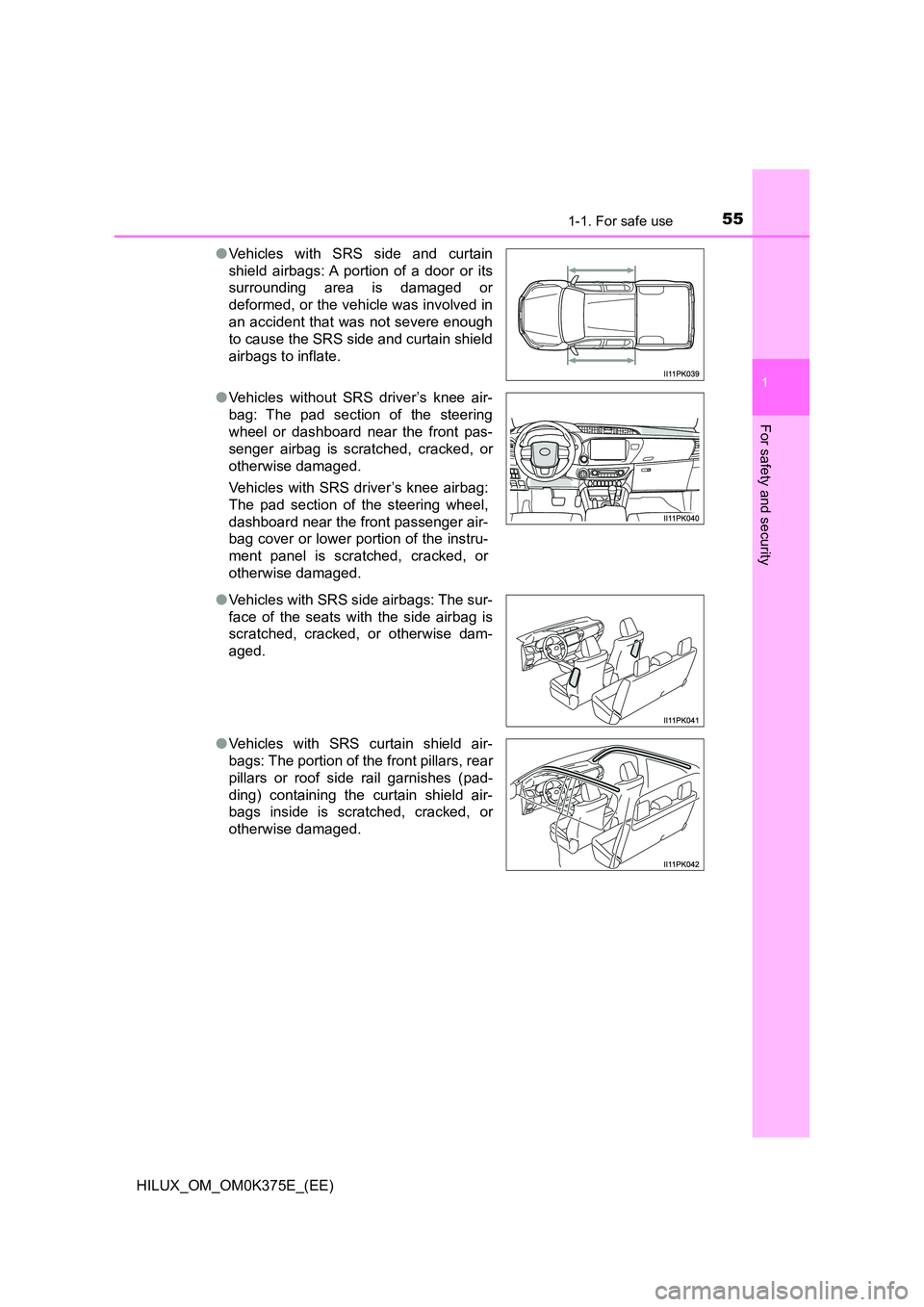
551-1. For safe use
1
HILUX_OM_OM0K375E_(EE)
For safety and security
●Vehicles with SRS side and curtain
shield airbags: A portion of a door or its
surrounding area is damaged or
deformed, or the vehicle was involved in
an accident that was not severe enough
to cause the SRS side and curtain shield
airbags to inflate.
● Vehicles without SRS driver’s knee air-
bag: The pad section of the steering
wheel or dashboard near the front pas-
senger airbag is scratched, cracked, or
otherwise damaged.
Vehicles with SRS driver’s knee airbag:
The pad section of the steering wheel,
dashboard near the front passenger air-
bag cover or lower portion of the instru-
ment panel is scratched, cracked, or
otherwise damaged.
● Vehicles with SRS side airbags: The sur-
face of the seats with the side airbag is
scratched, cracked, or otherwise dam-
aged.
● Vehicles with SRS curtain shield air-
bags: The portion of the front pillars, rear
pillars or roof side rail garnishes (pad-
ding) containing the curtain shield air-
bags inside is scratched, cracked, or
otherwise damaged.
Page 56 of 708
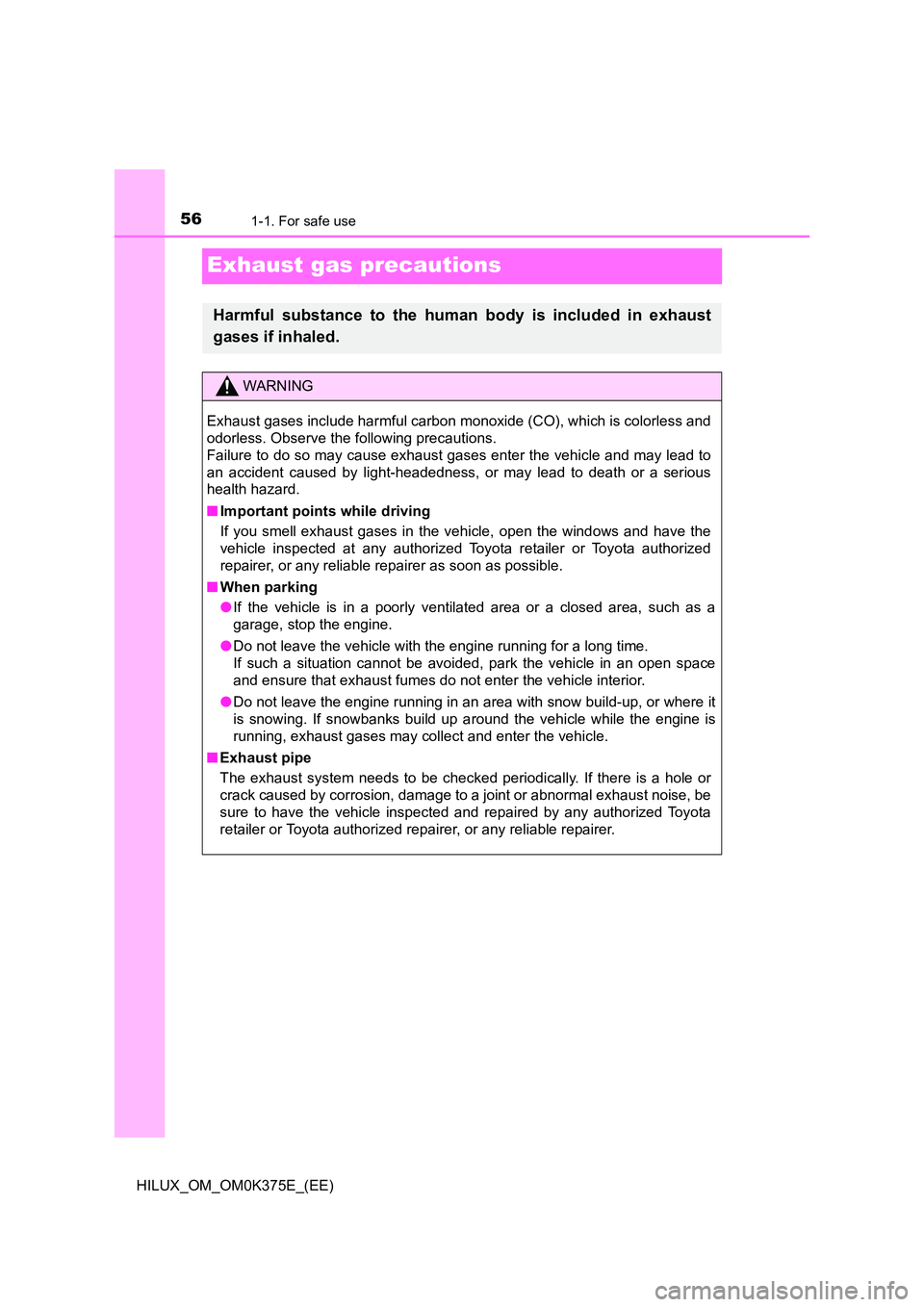
561-1. For safe use
HILUX_OM_OM0K375E_(EE)
Exhaust gas precautions
Harmful substance to the human body is included in exhaust
gases if inhaled.
WARNING
Exhaust gases include harmful carbon monoxide (CO), which is colorless and
odorless. Observe the following precautions.
Failure to do so may cause exhaust gases enter the vehicle and may lead to
an accident caused by light-headedness, or may lead to death or a serious
health hazard.
■ Important points while driving
If you smell exhaust gases in the vehicle, open the windows and have the
vehicle inspected at any authorized Toyota retailer or Toyota authorized
repairer, or any reliable repairer as soon as possible.
■ When parking
● If the vehicle is in a poorly ventilated area or a closed area, such as a
garage, stop the engine.
● Do not leave the vehicle with the engine running for a long time.
If such a situation cannot be avoided, park the vehicle in an open space
and ensure that exhaust fumes do not enter the vehicle interior.
● Do not leave the engine running in an area with snow build-up, or where it
is snowing. If snowbanks build up around the vehicle while the engine is
running, exhaust gases may collect and enter the vehicle.
■ Exhaust pipe
The exhaust system needs to be checked periodically. If there is a hole or
crack caused by corrosion, damage to a joint or abnormal exhaust noise, be
sure to have the vehicle inspected and repaired by any authorized Toyota
retailer or Toyota authorized repairer, or any reliable repairer.
Page 57 of 708
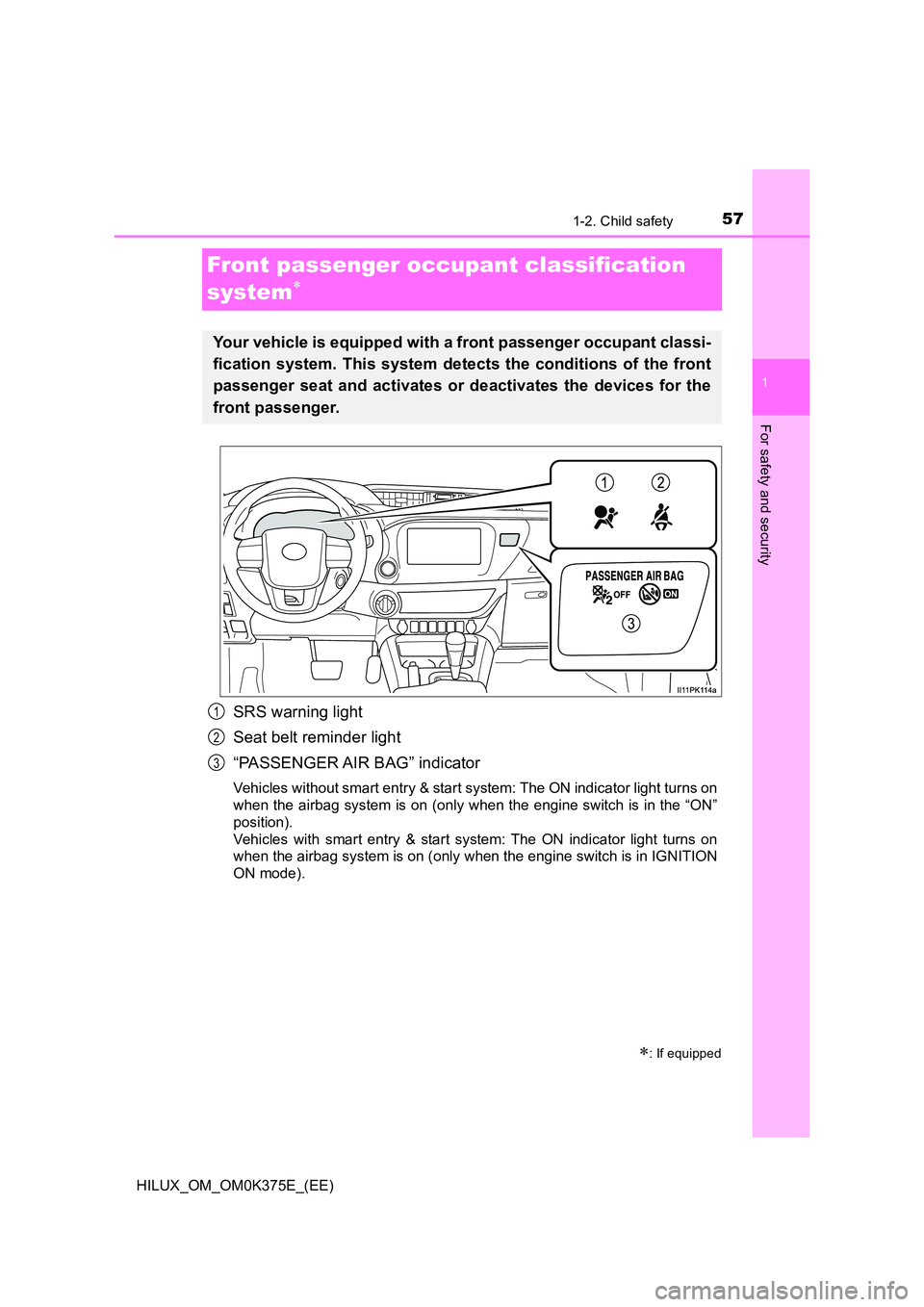
571-2. Child safety
1
HILUX_OM_OM0K375E_(EE)
For safety and security
Front passenger occupant classification
system
SRS warning light
Seat belt reminder light
“PASSENGER AIR BAG” indicator
Vehicles without smart entry & start system: The ON indicator light turns on
when the airbag system is on (only when the engine switch is in the “ON”
position).
Vehicles with smart entry & start system: The ON indicator light turns on
when the airbag system is on (only when the engine switch is in IGNITION
ON mode).
: If equipped
Your vehicle is equipped with a front passenger occupant classi-
fication system. This system detects the conditions of the front
passenger seat and activates or deactivates the devices for the
front passenger.
1
2
3
Page 58 of 708
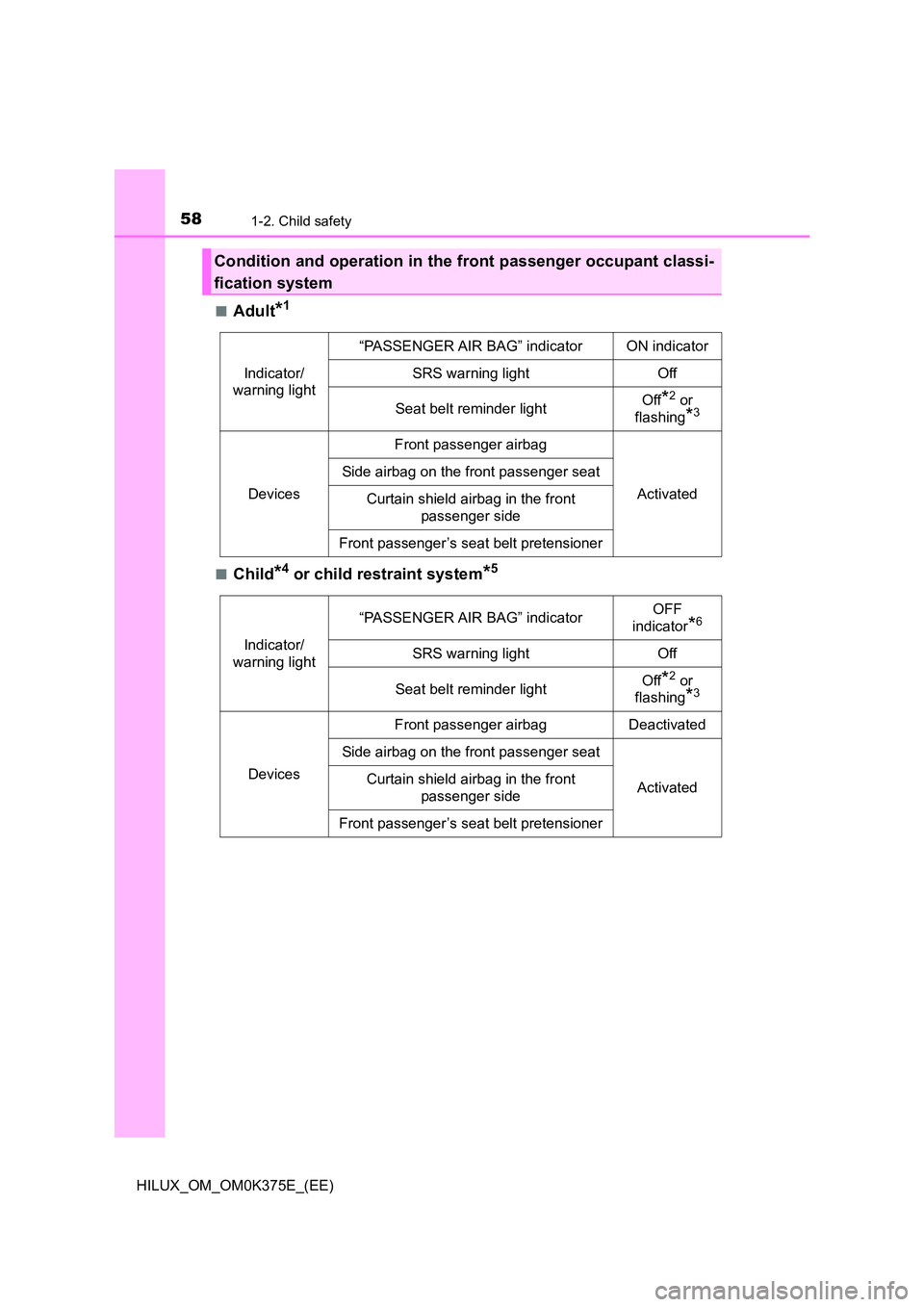
581-2. Child safety
HILUX_OM_OM0K375E_(EE)
■Adult*1
■Child*4 or child restraint system*5
Condition and operation in the front passenger occupant classi-
fication system
Indicator/
warning light
“PASSENGER AIR BAG” indicator ON indicator
SRS warning light Off
Seat belt reminder light Off*2 or
flashing*3
Devices
Front passenger airbag
Activated
Side airbag on the front passenger seat
Curtain shield airbag in the front
passenger side
Front passenger’s seat belt pretensioner
Indicator/
warning light
“PASSENGER AIR BAG” indicator OFF
indicator*6
SRS warning light Off
Seat belt reminder light Off*2 or
flashing*3
Devices
Front passenger airbag Deactivated
Side airbag on the front passenger seat
Activated Curtain shield airbag in the front
passenger side
Front passenger’s seat belt pretensioner
Page 59 of 708

591-2. Child safety
1
HILUX_OM_OM0K375E_(EE)
For safety and security
■Unoccupied
■There is a malfunction in the system
Indicator/
warning light
“PASSENGER AIR BAG” indicator OFF indicator
SRS warning light OffSeat belt reminder light
Devices
Front passenger airbag Deactivated
Side airbag on the front passenger seat
Activated Curtain shield airbag in the front
passenger side
Front passenger’s seat belt pretensioner
Activated*7
or
deactivated*8
Indicator/
warning light
“PASSENGER AIR BAG” indicator OFF indicator
SRS warning light On
Seat belt reminder light flashing
Devices
Front passenger airbag Deactivated
Side airbag on the front passenger seat
Activated Curtain shield airbag in the front
passenger side
Front passenger’s seat belt pretensioner
Page 60 of 708
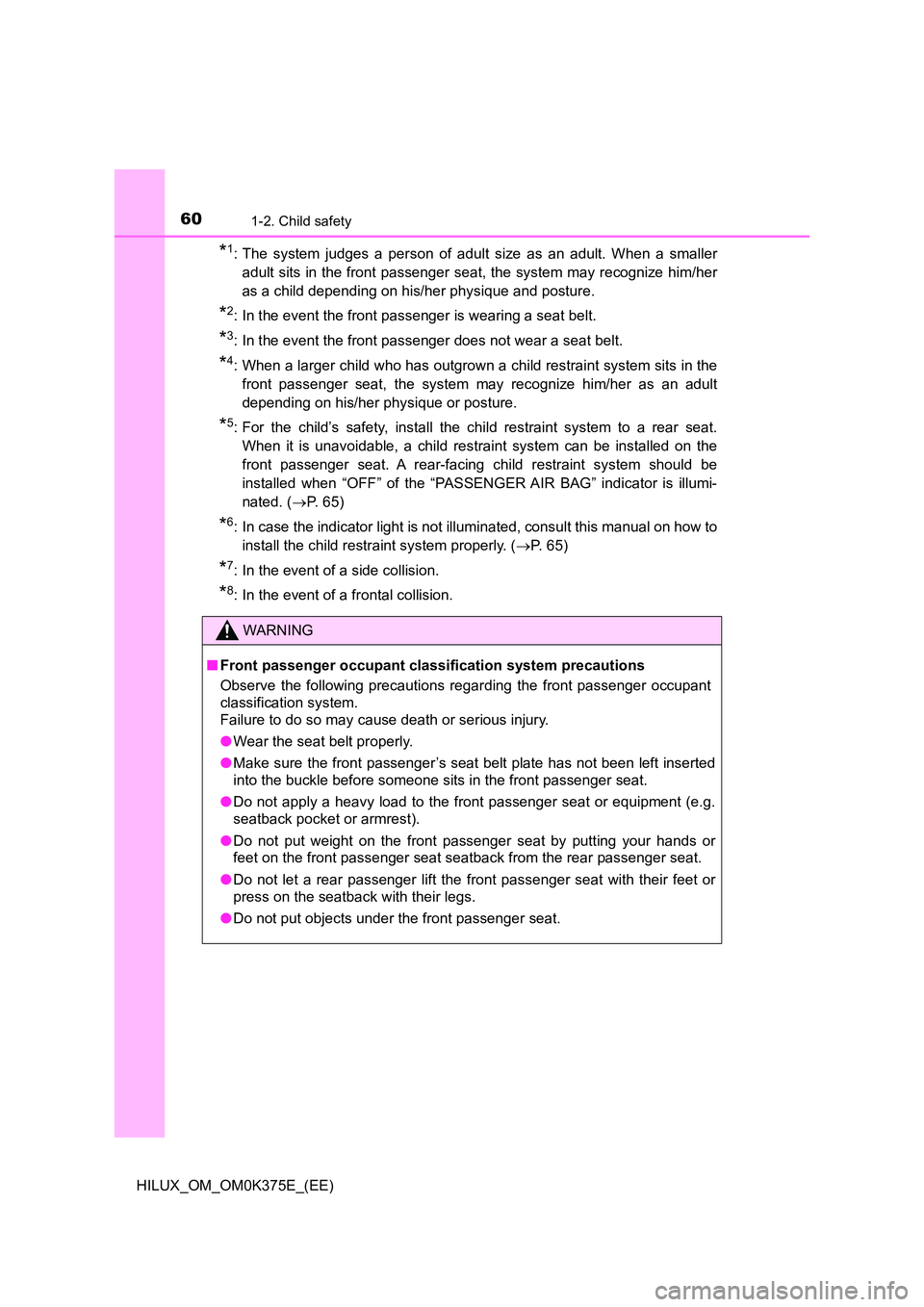
601-2. Child safety
HILUX_OM_OM0K375E_(EE)
*1: The system judges a person of adult size as an adult. When a smaller
adult sits in the front passenger seat, the system may recognize him/her
as a child depending on his/her physique and posture.
*2: In the event the front passenger is wearing a seat belt.
*3: In the event the front passenger does not wear a seat belt.
*4: When a larger child who has outgrown a child restraint system sits in the
front passenger seat, the system may recognize him/her as an adult
depending on his/her physique or posture.
*5: For the child’s safety, install the child restraint system to a rear seat.
When it is unavoidable, a child restraint system can be installed on the
front passenger seat. A rear-facing child restraint system should be
installed when “OFF” of the “PASSENGER AIR BAG” indicator is illumi-
nated. ( P. 6 5 )
*6: In case the indicator light is not illuminated, consult this manual on how to
install the child restraint system properly. ( P. 65)
*7: In the event of a side collision.
*8: In the event of a frontal collision.
WARNING
■Front passenger occupant classification system precautions
Observe the following precautions regarding the front passenger occupant
classification system.
Failure to do so may cause death or serious injury.
● Wear the seat belt properly.
● Make sure the front passenger’s seat belt plate has not been left inserted
into the buckle before someone sits in the front passenger seat.
● Do not apply a heavy load to the front passenger seat or equipment (e.g.
seatback pocket or armrest).
● Do not put weight on the front passenger seat by putting your hands or
feet on the front passenger seat seatback from the rear passenger seat.
● Do not let a rear passenger lift the front passenger seat with their feet or
press on the seatback with their legs.
● Do not put objects under the front passenger seat.